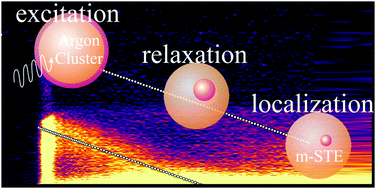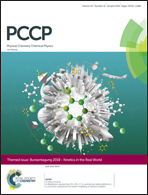Self-trapping relaxation decay investigated by time-resolved photoelectron spectroscopy†
Abstract
The present work combines time-resolved photoelectron spectroscopy on isolated species with high-level data processing to address an issue which usually pertains to materials science: the electronic relaxation dynamics towards the formation of a self-trapped exciton (STE). Such excitons are common excited states in ionic crystals, silica and rare gas matrices. They are associated with a strong local deformation of the matrix. Argon clusters were taken as a model. They are excited initially to a Wannier exciton at 14 eV and their evolution towards the formation of an STE has showed an unusual type of vibronic relaxation where the electronic excitation of the cluster decreases linearly as a function of time with a 0.59 ± 0.06 eV ps−1 rate. The decay was followed for 3.0 ps, and the STE formation occurred in ∼5.1 ± 0.7 ps.



 Please wait while we load your content...
Please wait while we load your content...